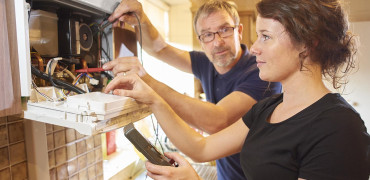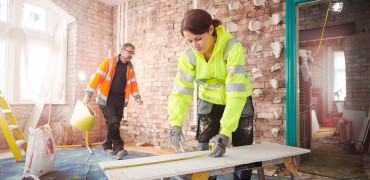How are we going to decarbonising existing buildings in the commercial sector to hit our national carbon reduction targets?
One option is to offer clients the ability to retain their existing boiler.
The ethos behind air source heat pump specification is often to replace your boiler, however, many businesses may well find that a tall order in these tough financial times.
A hybrid system that lets them keep their boiler can enable them to provide a low carbon solution to fix their climate data, while not ‘upsetting the apple cart’ of their existing heating infrastructure completely.
This could mean far less disruption to their business, while attaining the emissions reductions we all need. It could even mean that commercial assets as a whole are able to be retained towards the net zero 2050 target, rather than being rendered obsolete by their existing, high-carbon heating system.
A bivalent system can offer businesses a pragmatic and sensible way to transition away from gas
Working in isolation
In what is known as a bivalent system – a heat pump works alongside an existing boiler which can reduce carbon with the heat pump taking the lion’s share of the load.
This can also potentially extend the life of the boiler and might be the pragmatic option that enables many clients to attack the retrofit challenge.
There are two options with these hybrid systems, firstly the two systems working separately so that one is ‘off’ while the other is ‘on’ and they share the workload throughout the year, delivering different flow temperatures depending on the operation requirements.
The heat pump delivers the carbon reduction and efficiency benefits, while the gas boiler kicks in when the outside temperatures drop or if there is unexpected demand on the heating or hot water requirements.
The heat share from the heat pump will be lower in this first option but the building owners will still be able to reduce emissions and it will require less system changes.
Working together
The second option – bivalent in parallel, sees the two systems working together and intelligently working out how to best manage the requirement.
They deliver the same temperatures and operate independently and simultaneously. This does require a lower heating system flow temperature, but the efficiency is much greater because the heat share from the heat pump is much higher.
Both systems can help decarbonise the building and reduce operational costs, while improving the Energy Usage Intensity (EUI) and improve the building’s Energy Performance Certification (EPC).
Heat emitters
With any building the heat output or energy that can be delivered into a space by any heat source is limited by the connected heat emitters.
To maximise the carbon reduction benefits the building owners can:
- Increase the heat emitter size (e.g. with larger or smarter radiators)
- Increase the flow temperature (which decreases carbon reduction)
- Reduce the building’s overall heat load (which should be the first step in looking to reduce carbon and maximise efficiency).
The ideal solution will be one that keeps the flow temperatures as low as possible and that’s where a bivalent system can offer businesses a sensible way to transition away from gas.
The retrofit challenge is colossal, and pragmatic approaches like retaining existing heating infrastructure while achieving high emissions reductions are what is required, and required now.
James Parker, Editor of Architect’s DataFile




